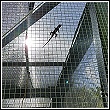Florida Iguana Control
Iguanas In The Attic - Fox 4 News Coverage
The Wildlife Whisperer recently made the news when Ned Bruha was called in to solve a family's apparent Nile monitor problem.
After the story aired, Bruha took various steps to discover what was truly causing the problem ... Nile monitors or something else?
As it turned out, Bruha discovered the family didn't have a Nile monitor living in their attic, they had iguanas - several of them.
It is not uncommon for iguanas, Nile monitors and other lizards to invade attics in search of food and shelter.
Iguanas In Florida
The Florida iguana population has everything it needs to thrive in Southwest Florida - few predators to worry about, a warm sub-tropical climate, lots of water, a burrow friendly landscape, abundant vegetation and plenty to eat. From an iguana's perspective, Florida has it all.
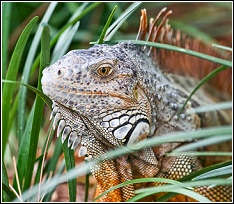
There are three kinds of iguanas commonly found in Florida; the green iguana, Mexican spiny-tailed, and black spiny-tailed iguana.
The Mexican spiny-tailed iguana is commonly found in and around Dade county, however, there have also been documented sightings in Southwest Florida, including Cape Coral and Fort Myers.
Regarding the green iguana, in Southwest Florida, Lee county has the highest number of sightings, followed by Charlotte, Monroe and Collier - but all of the counties in the area have had some sightings.
The Green Iguana
Green iguanas are not always green, they can also be black, brown, gray or dark green. Some male iguanas will turn an orange like color during breeding season. The green iguana grows to around 4' in length from head to tail, and as seen below, adults have black bands on their sides and tails. The green iguana tends to live close to the water, and is excellent at swimming and climbing trees.
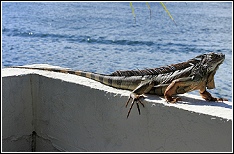
The green iguana is a herbivore, but on occasion may eat wild bird eggs. As a herbivore they are not as much of a threat to the local wildlife population as some of the other lizards, however their eating and nesting habits have made them a problem for many Florida residents.
The Mexican And Black Spiny Tailed Iguanas
The black spiny tailed iguana, as seen in the photo immediately below tends to be grey, black or brownish in color. They have a long tail spiked with spines running along the top, which are actually scales. Black iguanas feed on vegetation but will also eat smaller animals, eggs, and arthropods when provided with the right opportunity.
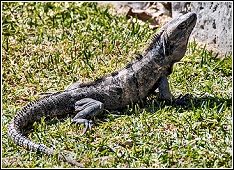
Black spiny-tailed iguanas are most active during the day. These iguanas are usually shy, however, they are quick to defend themselves and will hiss, bite and scratch while attempting to do so. They are also known to "slap" their tails around while trying to defend themselves, and their tails can pack a pretty good wollup. They like to hide in burrows and dig under sidewalks and sea walls. Like the green iguana, their pooping, eating and nesting habits have made them a problem in Southwest Florida.
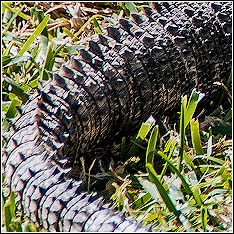
The photo above shows a close up view of the spiny features found on top of a spiny iguana's tail. Notice how thick and strong it is too.
The Mexican spiny tailed iguana, is similar in appearance to the black spiny tailed but it tends to have more of a yellow based body color.
If you see an iguana, there are a few things that can help you distinguish between the three different types of iguanas found in Florida - something that can be very important to know when it comes to determining which methods of iguana control will work best for you.
All three iguanas average around 4' from head to tail, many can grow larger, with some reaching over 6'. The green iguana, like the one seen immediately below, has a distinct dewlap (hanging skin) under its jaw, although the dewlap will not always be as large as the one below.
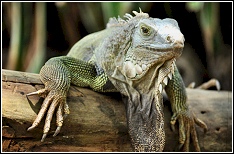
All three lizards have a spiny appearance on top of their bodies, however, the green iguana does not have a prominent spiny appearance on top of its tail like the black spiny tailed and Mexican spiny tailed do.
When trying to escape, green iguanas have a tendency to dive into the water whereas the spiny tailed iguanas will usually retreat to a burrow.
On occasion, iguanas are mistaken for young alligators.
The Problem With Iguanas
A lot of Florida residents enjoy watching iguanas and having them around, but their behavior and rapid population growth has become a real problem in many areas across the state.

Iguanas are primarily herbivores but will also eat bird nestlings and eggs, insects, small animals and crustaceans. Expensive landscaping is often destroyed by iguanas living nearby, including shrubs, trees, hibiscus, orchids, and many other flowers. Bananas, figs, mangoes, berries and even tomatoes can also fall victim to hungry iguanas.


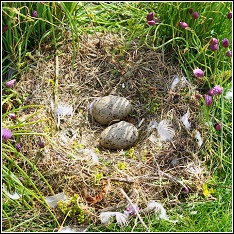
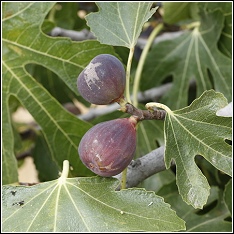
The University Of Florida has established a list of food plants that are attractive to iguanas which includes, but is not limited to, the following plants commonly found around homes in the region ...
- Hibiscus
- Orchids
- Roses
- Impatiens
- Bougainvilleas
- Nasturtiums
- Kale & Broccoli
- Collards
- Beets
- Lettuces
- Squashes
- Melons
- Fruits
- Flowers
- Turf Grass
- New Growth
If you have a lot of these plants, getting rid of iguanas around your property will be a difficult thing to do.
Iguana poop can also become particularly problematic, covering sidewalks, driveways, decks and pool areas. Iguana feces can be unsightly, cause a terrible odor and carry the salmonella bacteria.
The nesting and burrowing habits of iguanas have also led to a lot of concerns and are one of the reasons that iguana control needs to be in place throughout southern Florida. Iguanas like to live in burrows, particularly behind sea walls. Creating burrows behind sea walls leads to erosion and potentially a collapse in the seawall itself. The black tailed spiny iguana will also steal burrows from other animals, making it a particular threat to the native burrowing owl found in the area.

Iguanas themselves can be a hazard. Normally, they are not aggressive but will defend themselves, their territories or their nests when they are cornered or feel the need to do so. They are large, powerful animals with sharp teeth and large claws that will bite and scratch - making them hazardous to confront for both people and their pets.
If you see an iguana, do not pick it up, call a professional - iguanas can be very dangerous and you could get seriously hurt.
Iguanas have been known to cause all kinds of damage, including sparking power outages, nesting in attics, and getting into homes. They dig burrows under concrete foundations, and will disturb garbage cans in search of food. You do not want iguanas taking up residency. Call us today to fix your iguana problems before they get out of hand.
Why Wild Iguanas Do So Well In Southern Florida
There is a reason why most of the iguanas in Florida are found in the southern half of the state - iguanas require warmer temperatures, preferably in the 80's and 90's. Once temperatures start to fall below 40º, an iguana will go into a kind of "frozen" state of hibernation, and will die a few days later if temperatures don't go back up.
There is another reason why iguanas have done so well in the southern region of the state. In their natural Mexican habitat, the iguana population was controlled by a balanced eco-system - parasites, predators and disease kept the iguana lizard population at a controllable level there. However, a lot these controlling factors are missing in southern Florida, and there is little to keep their population at acceptable levels.
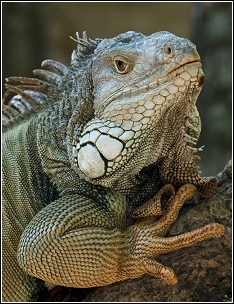
How To Get Rid Of Iguanas
If you are wondering how to keep iguanas away, there are some things that you can do to help get rid of iguanas around your home and on your property. Trapping iguanas is one of the most common ways to get rid of them, however, you will also need to take preventative steps including iguana proofing your home and modifications around your property, or the problem will quickly repeat itself. We can help you with every step of the iguana pest control process from start to finish.
Iguana Removal
If you go the trapping route to get rid of your iguana problem it is important to know that although trapping is allowed, poisoning is not. You are allowed to trap iguanas, but by law, the process you use must fall within the legal guidelines established by the State Of Florida.
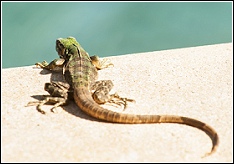
Iguanas (including those in the wild) are protected by the state's anti-cruelty laws. Another important thing to know about getting rid of iguanas via trapping is that relocation is not permitted. This makes sense considering that their population is increasing at a problematic rate. Professionally captured iguanas must be euthanized by one of the methods approved by the state. "Freezing" the iguana is one of the most common euthanization methods used by iguana control experts.
We can certainly help you trap and remove your problem iguana, but just as important, we can help you keep them from coming back.
How To Keep Iguanas Away
As is often the case with wildlife, prevention can go a long way toward preventing an iguana problem from getting started or recurring.
If iguanas are trapped and removed without taking steps toward excluding them from your home, lanai or property, then one will certainly move in to take its place, and take it quickly.
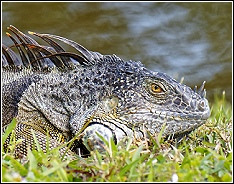
The Homes Around Them Too
Better to proof your property to discourage them from settling in to start with. Exclusion is the best kind of iguana control.
We can make simple modifications to your home, around your pool, on your lanai and in other areas of your property that will exclude them from getting into or returning to these places.
We even offer lanai screen repair services and can proof, clean, repair, install or modify your screens to keep bugs and wildlife out.
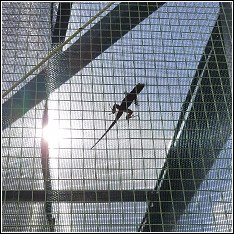
Lanai Repair & Installation Services
It is also helpful to remove attractions around your property where you can. For instance cutting back on or proofing food rich resources such as gardens, fruit trees and vegetable gardens. Iguanas love to hang out around rock landscaping and in trees, so something as simple as thinning out your tree branches and choosing smart landscaping can go a very long way toward better iguana control around your home.
If you can't or don't want to remove tempting landscapes, proofing can often be a viable substitute. For instance, sheet metal guards can be installed on trees to keep them from climbing up to the branches, barriers and guard screens can be utilized to keep them out of gardens, pools and lanais, and trees that allow access to your roof top can be trimmed back. Child proof and electric fencing can also be helpful.
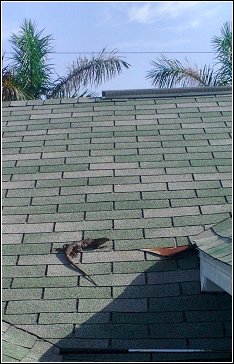
Captured On Trail Cam
Iguanas love attics - climbing up walls and utilizing trees to access your roof and attic is no problem for them. But not to worry, when it comes to your actual home and lanai, we can make the necessary modifications to keep them out. It is important to use a professional that understands construction and what to look for regarding what iguanas will utilize to get inside. Otherwise, the problem will just keep repeating itself.
We know how to iguana proof your home, and exclude them for good.
1242 SW Pine Island Rd., Suite 310
Cape Coral, Florida 33991-2126
help@totalwildlifecontrol.com




